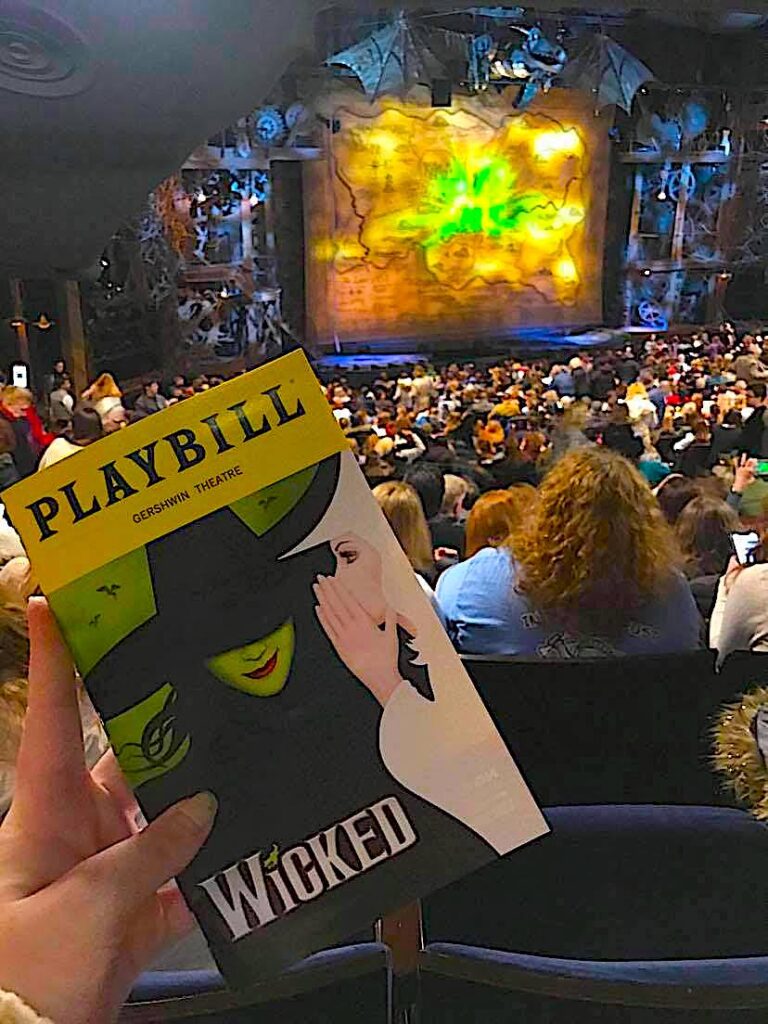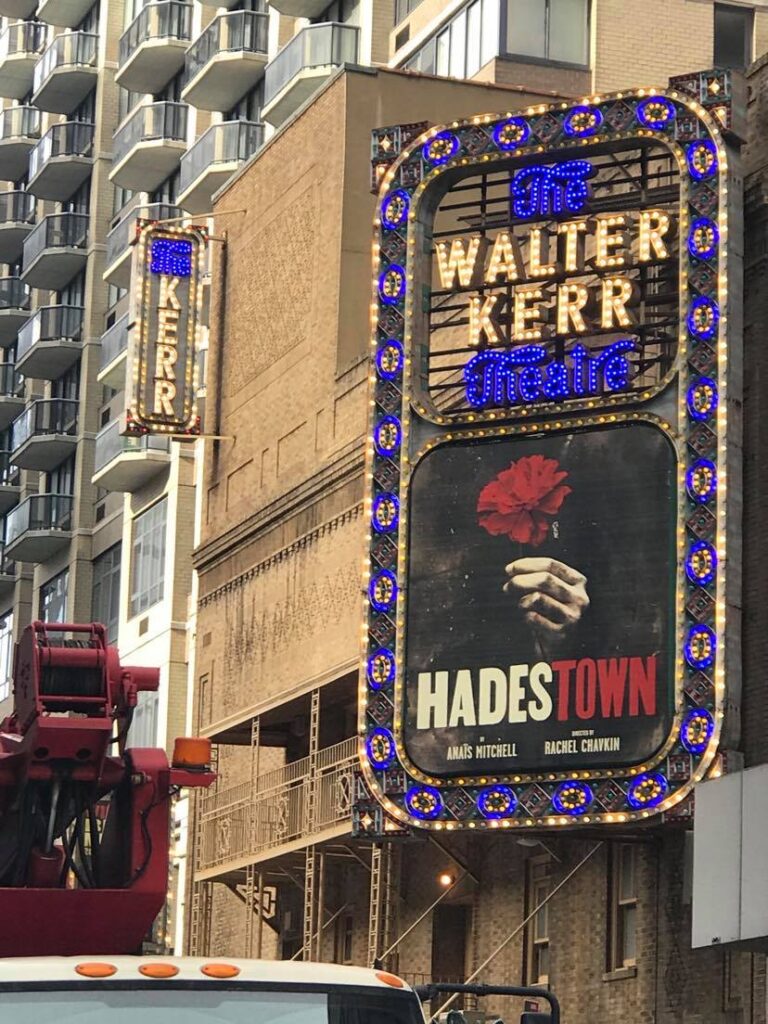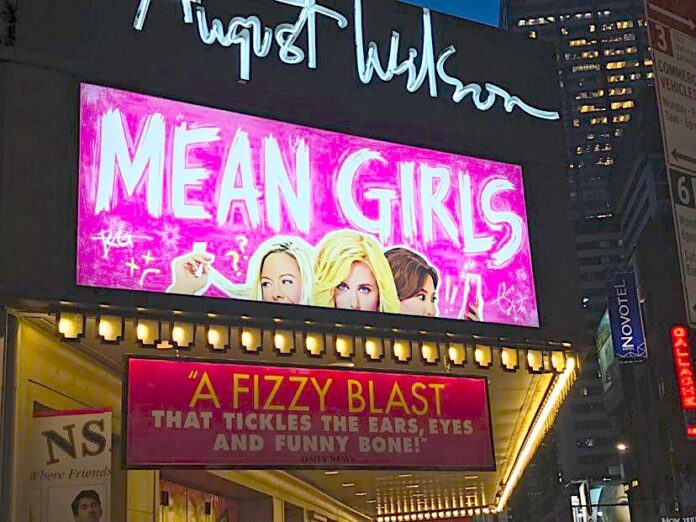The abrupt closure of Broadway put nearly 100,000 people out of work, and robbed the New York theater world of $14.8 billion.
What will a post-pandemic Broadway world look like?”
In an early 2021 virtual conference presented by the Association of Performing Arts Professionals, Dr. Anthony Fauci, the top U.S. infectious disease expert, said he believed theaters and other performance venues could reopen in the fall of 2021. Whether his prediction can come true depends upon a variety of factors, including a successful rollout of the COVID-19 vaccine.
 Acting is an intimate art form, requiring people to be within six feet of each other. While rehearsing and performing in a socially distanced manner is unrealistic, some theaters have managed to successfully adopt safety precautions.
Acting is an intimate art form, requiring people to be within six feet of each other. While rehearsing and performing in a socially distanced manner is unrealistic, some theaters have managed to successfully adopt safety precautions.
At the Indiana Repertory Theatre, a professional regional theater whose actors aspire to performing on Broadway, the cast of No. 6 was in the winter of 2021 preparing for opening night. Luckily, safety measures have kept the actors healthy through rehearsals.
“We are tested twice a week for COVID, and basically exist in ‘Zone A’ when at work,” said Michael Stewart Allen, who plays Kelly in No. 6. “[Everything] else is done on Zoom, including our meet and greet, and costume fittings.”
Smaller classes and distanced rehearsals
Masks are a must while the actors are blocking a scene, and all have stations in separate corners of the room, where they take socially-distanced breaks. Props are frequently sanitized, and the rehearsal space is cleaned at the end of each day. While these new guidelines felt strange at first, Stewart Allen admitted that acting felt familiar and good again.
“Difficulties are obvious in not being able to see the whole face while rehearsing,” he said. However, “working on a scene with someone wearing a mask makes you focus more intently on your scene partner’s eyes and makes you listen more intently somehow, [which is] not a bad thing.”
“Difficulties are obvious in not being able to see the whole face while rehearsing. [But] working on a scene with someone wearing a mask makes you focus more intently on your scene partner’s eyes, and makes you listen more intently somehow.”– actor Michael Stewart Allen
Rehearsals have been successful so far, Stewart Allen said, and thankfully, no one has fallen ill. While he is unsure that COVID-19 can be completely kept out of a theater, he said he felt very safe at work. From this performing experience, Stewart Allen strongly advises Broadway productions to regularly test for COVID-19, as he believes this is the best way to keep everyone healthy.
“A commercial enterprise like a Broadway show could test the actors and staff daily if needed,” Stewart Allen said. “Nonprofit regional productions simply cannot afford that.”
For Sophia Nitkin, a Rutgers graduate who assists at her family’s acting studio, routinely testing her students was not financially feasible. Unfortunately, the studio was forced to conduct classes virtually this past year, causing both end-of-term dramas to be pre-recorded and live-streamed. To make it easier to teach virtually and to be able to give her undivided attention to each student, Nitkin also shrank class attendance. When classes restart, she plans to limit attendance to three or four students.
They were at work on a production Nitkin wrote herself.
“The process was completely different, because it affected the way the production would’ve felt live,” Nitkin said. “Even the songs had to be pre-recorded, and a lot of audio editing went into it. It felt like creating a movie rather than a play.”
Nitkin struggled to motivate her students, and to get them to express themselves fully. Acting, as she stated, is such an expressive, full-body experience, and it’s especially hard to project emotions virtually.
“The rehearsal process used to just be in class every week, but now, it’s all virtual,” she said. “The students were disillusioned because they were supposed to have their show in Symphony Space on 96th and Broadway. But we tried to keep their spirits up in creative ways.”
In addition to worrying about how actors will adapt to a post-pandemic theatrical world, one needs to consider how other parts of a musical production, such as the orchestral pit, will adjust.
Obstacles for orchestras
 The musicians who help create the beautiful instrumental tracks for Broadway musicals are usually stationed beneath the stage, in a small orchestra pit, often sitting exceptionally close to one another. It’s clear that drastic changes will need to be made in the future to keep musicians safe.
The musicians who help create the beautiful instrumental tracks for Broadway musicals are usually stationed beneath the stage, in a small orchestra pit, often sitting exceptionally close to one another. It’s clear that drastic changes will need to be made in the future to keep musicians safe.
Ben Harris, a Rutgers University music major, has played in his fair share of orchestral pits. His specialties include flute, saxophone, clarinet and their many variations. As a musician, he’s found the pandemic extremely challenging.
“That kind of interaction you have with other people is something that I definitely took for granted now that it’s [been taken] away from me,” Harris said. “I would sometimes dread going to large ensemble rehearsals that I’d have to go to for my major, but I would do anything to go back to that now.”
“That kind of interaction you have with other people is something that I [realize that I] definitely took for granted, now that it’s [been taken] away from me. I would sometimes dread going to large ensemble rehearsals that I’d have to go to for my major. But I would do anything to go back to that now.” — music student Ben Harris
Harris has not participated in a large pit during the pandemic; he’s heard there’s a greater risk, in large gatherings, of musicians contracting the coronavirus. With any musical device that requires air to create sound, you’re projecting saliva into your instrument, which is then dispersed into your surroundings, Harris said. While singers can wear masks to keep themselves and others safe, it’s more complicated for musicians.
There are a few successful safety protocols that Broadway orchestras can implement, Harris explained. For some musicians, such as pianists or drummers, masks should provide sufficient protection. But for wind instrumentalists, additional safety precautions will likely need to be taken.
“There’s one way where you’re literally catching the air that’s coming out of your instrument with essentially a bag,” he said. “There are also bell covers for saxophone, clarinet, trumpet, all the brass instruments. [They] kind of look like a stocking that goes over the end of the bell and that is supposedly good at catching anything that comes out.”
Even with these safety measures, musicians risk air leaking through the instrument’s tone holes as they perform. For this reason, Harris also suggests that orchestras install plexiglass dividers between instrumentalists if the pit has adequate space. As someone who aspires to work on Broadway, Harris is both hopeful and nervous about Broadway’s future once COVID-19 restrictions ease.
Audiences must adjust
As an industry that thrives on tourism, Broadway will continue to be hampered by the pandemic. In the most recent complete season, tourists paid for 65 percent of ticket sales, according to the Broadway League, which represents theater owners and producers. Some theater experts speculate that legacy productions such as Phantom of the Opera and Wicked, which depend heavily on tourism, will ultimately close.
Harris disagrees.
“The shows that currently have a huge [fan]base like Wicked, Phantom, Lion King, those are 100 percent going to stay open for the foreseeable future,” he argued. “I don’t see a reason as to why they would close. I mean, Wicked is a $1 billion company; [it] could survive several pandemics.”
Once theaters are allowed to reopen, new safety guidelines will need to be enforced for audiences, too.
“Until we are fully out of the woods from this pandemic, theaters will have to be creative about how and where they place the audience,” said Jeff Bender, a Rutgers University theater professor. “The best option right now is to keep patrons six to eight feet apart. Unfortunately, that limits the amount of people that can fit in a theater, especially smaller theaters.”
Much as for restaurants, Bender believes that there will be an audience capacity theaters must respect. As more people get vaccinated, he expects there to be a shift in the way theaters manage audiences.
While it won’t be easy for Broadway to return, Bender hopes the industry will come out of the pandemic stronger, and that fans won’t take the performing arts for granted.
“Theater might be a little different for a while, but the art of theater remains the same,” he said. “I think that people will crave social interaction more than ever, and I truly believe that the arts, theater, in particular, can fill this void.”


